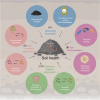Synthetic microbial communities: Sandbox and blueprint for soil health enhancement
- PMID: 38868511
- PMCID: PMC10989119
- DOI: 10.1002/imt2.172
Synthetic microbial communities: Sandbox and blueprint for soil health enhancement
Abstract
We summarize here the use of SynComs in improving various dimensions of soil health, including fertility, pollutant removal, soil-borne disease suppression, and soil resilience; as well as a set of useful guidelines to assess and understand the principles for designing SynComs to enhance soil health. Finally, we discuss the next stages of SynComs applications, including highly diverse and multikingdom SynComs targeting several functions simultaneously.
© 2024 The Authors. iMeta published by John Wiley & Sons Australia, Ltd on behalf of iMeta Science.
Conflict of interest statement
The authors declare no conflict of interest.
Figures


References
-
- Caesar‐TonThat, The Can , Espeland Erin, Caesar Anthony J., Sainju Upendra M., Lartey Robert T., and Gaskin John F.. 2013. “Effects of Agaricus Lilaceps Fairy Rings on Soil Aggregation and Microbial Community Structure in Relation to Growth Stimulation of Western Wheatgrass (Pascopyrum smithii) in Eastern Montana Rangeland.” Microbial Ecology 66: 120–131. 10.1007/s00248-013-0194-3 - DOI - PubMed
-
- Erktan, Amandine , Rillig Matthias C., Carminati Andrea, Jousset Alexandre, and Scheu Stefan. 2020. “Bacterial and Fungal Predator—Prey Interactions Modulate Soil Aggregation.” Biogeosciences Discussions 1–31. 10.5194/bg-2020-48 - DOI
Publication types
LinkOut - more resources
Full Text Sources
